
Rene Lalique 'Le Jade' Green Glass Scent Bottle, 1926
A Rene Lalique 'Le Jade' opaque green glass scent bottle, Lalique for Roger et Gallet, Paris, 1926, in Chinese snuff bottle form, moulded with a parrot against a scrolling thicket of branches. Impressed 'Roger Et Gallet / Paris' verso, also monogrammed 'R…

Collection of Nine Assorted Perfume Bottles Including Lalique
Nine assorted perfume bottles including Lalique, the largest 14 cm high

Assorted Vintage French Glass Perfume Bottles, Including Lalique, Deaville
Six assorted vintage French glass perfume bottles including Lalique for Nina Ricci, Deaville eau de cologne and others, the largest 22 cm high

Collection of Eleven Assorted Perfume Bottles, Including Lalique
Eleven assorted perfume bottles including Lalique for Worth, the largest 11 cm high

Assorted French Vintage Glass Perfume Bottles, Including Lalique and Dora
Four assorted French vintage glass perfume bottles including Lalique and Dora Flor, the largest 15 cm high

Vintage perfume bottles and cosmetics including Lalique, Worth, and more
Assorted perfume bottles, cosmetics and packaging including Lalique, Worth and others, mixed vintages, (quantity)

Lalique Crystal Apple Scent Bottle for Nina Ricci Perfume
A Lalique crystal apple scent bottle, for Nina Ricci 'Grande Pomme', frosted body with leaf stopper. Height 15 cm.

Lalique 'Je Reviens' French Glass Perfume Bottle, 10cm High
Worth 'Je Reviens' French glass perfume bottle by Lalique, 10 cm high

Worth 'Je Reviens' Set: Lalique Bottles in Original Boxes
Worth 'Je Reviens' in original box, bottle stamped 'Lalique, made in France, Worth'; together with two bottles Worth 'Je Reviens' Eau de Cologne in original boxes, both bottles stamped 'Lalique', (3 items), the bottles 8 cm and 9.5 cm high

French Lalique Perfume Bottles Collection: Five Assorted Glass Pieces
Worth group of five assorted perfume and eau de toilette French glass bottles, one in original box, another on original display stand, three blue lidded examples stamped 'R. Lalique', the two spherical examples stamped 'Lalique', the largest 13.5 cm

Vintage Lalique Requete French Perfume Bottle with Original Labels
Worth 'Requete' vintage French perfume bottle, bearing two original paper and string labels and engraved stopper, circa 1944, base branded 'Lalique, France', 9 cm high

Vintage French Lalique Worth Glass Perfume Bottles with Stoppers
Worth group of three vintage French glass perfume bottles with original stoppers, in three sizes, bases branded 'Lalique, made in France, Worth', 14 cm, 8 cm and 7.5 cm high

Lalique for Worth French Art Deco Perfume Bottle Set
Lalique for Worth French Art Deco two bottle perfume set in stand, circa 1930, stand acid etched 'R. Lalique, France', the bottles 12.5 cm high, the stand 3.5 cm high, 15 cm wide

Assorted Vintage French Glass Perfume Bottles Including Lalique for Coty
Seven assorted vintage and antique French glass perfume and cologne bottles including Lalique for Coty, the largest 26 cm high

Lalique for Coty French Perfume Bottles Set, 13.5cm High
Lalique for Coty set of six French perfume bottles, 13.5 cm high

French Art Deco Glass Perfume Bottle by R. Lalique, 1938
Worth 'Imprudence' French Art Deco glass perfume bottle, circa 1938, stamped 'R. Lalique, France, Bottle', 8 cm high

Lalique French Art Deco Grey Stained Perfume Bottle, 1925
Lalique French Art Decosquare form perfume bottle with grey stained finish, circa 1925, stamped 'R. Lalique, Paris, France', 13.5 cm high

Lalique 'Heliotrope' French Glass Perfume Bottle for Houbigant 1919
Lalique 'Heliotrope' French glass perfume bottle, designed for Houbigant in 1919, impressed 'Lalique', 8 cm high

Lalique 'Le Lys' French Glass Perfume Bottle for d'Orsay
Lalique 'Le Lys' impressive French glass perfume bottle with brown staining for d'Orsay, stamped 'R. Lalique', 21.5 cm high

Lalique 'Le Lys' French Glass Perfume Bottle for d'Orsay
Lalique 'Le Lys' French glass perfume bottle for d'Orsay, 17.5 cm high

Lalique 'Hirondelles' French Art Deco Blue Stained Perfume Bottle
Lalique 'Hirondelles' French Art Deco perfume bottle with blue stained finish, circa 1920, engraved 'R. Lalique, France', 9 cm high

Lalique French Art Glass Perfume Bottle: Engraved and Elegant
Lalique French art glass perfume bottle, engraved 'Lalique, France', 12 cm high

1922 Rene Lalique Cologne Bottles for D'Haraud Paris
Two Rene Lalique cologne bottles for D'Haraud Paris circa 1922 in moulded clear glass with frosted stoppers, (2)

Lalique Telline Clam Perfume Bottle
Rene Lalique, Flacon Telline, model no. 508 designed 1920, coloured glass, of a clam with similar stopper, moulded signature to base, chip to rim grounded down (A/F), height 9.5 cm. Provenance: Private Collection, Sydney

Lalique Nina Ricci Perfume Bottle in Original Box
A Lalique Nina Ricci L'Air du Temps perfume bottle, height 9.5 cm fitted in original satin yellow box

Lalique Samoa Perfume Bottle - $950 Retail
A Lalique Cristal 'Samoa', perfume bottle clear, height 8 cm. Historic retail $NZ950

Lalique Frosted Glass Perfume Bottles in Original Box
Lalique French frosted glass perfume bottles in original box, mid to late 20th century, engraved 'Lalique, France', 9 cm high, 9 cm wide

Nina Ricci & Lalique Perfume Bottles with Fragrance Set
A Nina Ricci, Lalique, perfume bottle with perfume together with another, height 7 cm and 9 cm

R. Lalique Blue Glass Perfume Bottle with Stopper
Worth perfume bottle, blue glass with stopper by R. Lalique, height 7.5 cm

Molinard de Molinard Lalique Perfume Bottle
Mid 20th century Molinard de Molinard perfume Creation Lalique bottle moulded frosted frieze with matching stopper 11 cm

Nina Ricci Lalique Store Display Perfume Bottle with Chip
Lalique LAir du Temps large Store display factice perfume bottle designed by Nina Ricci, height 32 cm, chip to base of stopper and wing

Lalique Deux Fleurs Crystal Perfume Bottle
Lalique, a 'Deux Fleurs' crystal perfume bottle designed as two overlapping flower heads with matching stopper, signed Lalique, height 9 cm, width 9.30 cm.

Lalique Pinched Rim Perfume Bottle - 16.5cm Height
Requete perfume bottle, height 16.5 cm a Lalique Pinched rim perfume bottle, height 16.5 cm

Lalique Moon and Stars Perfume Bottle - 26cm Height
A Dans La Nuit, Lalique, giant 'Moon and Stars' matte blue bulbous perfume bottle, height 26 cm

Lalique Blue Skyscraper Perfume Bottle - 31.5 cm Height
A Lalique Je Reviens 'Skyscraper' blue perfume bottle, height 31.5 cm

Lalique Je Reviens Moon and Stars Perfume Bottle
A Lalique Je Reviens giant 'Moon and Stars' decorated perfume bottle, height 26 cm

Lalique Skyscraper Perfume Bottle, 31.5 cm Height
A Lalique Je Reviens 'Skyscraper' perfume bottle, height 31.5 cm

Lalique Crystal Lily of the Valley Scent Bottle
Lalique crystal decorative scent bottle with decorative lily of the valley stopper, marked to base and original paper label attached, height 11 cm.

Rene Lalique Antique Ambre Perfume Bottle, c.1910
Rene Lalique Ambre antique perfume bottle, for Francois Coty, c.1910, of tapered form, decorated with four classical maidens holding flowers, in sepia on frosted glass, impressed R.Lalique, height 17 cm (including stopper)

Rene Lalique Cactus Perfume Bottle - Frosted Satin Glass
Rene Lalique Cactus perfume bottle, of globular form, in satin frosted glass with black accents, signed R Lalique France to base, with molded France mark, slight a/f, height 10 cm

Lalique Heart-Shaped Scent Bottle for Nina Ricci Perfume
Lalique scent bottle, French crystal heart shape bottle with stopper, marked Lalique to base made for Nina Ricci 'Coeur Joie' perfume

Frosted Lily of the Valley Lalique Scent Bottle
Lalique scent bottle, frosted lily of the valley design to stopper, engraved signature to base Lalique France

Lalique 'Thais' Crystal Perfume Bottle in Box
Lalique France 'Thais' crystal perfume bottle etched to base, in original box, height 7 cm

Lalique Mermaid Perfume Bottle
Lalique 'Les Sirenes' 2001 perfume Flacon Collection, compressed globular bottle raised on shoulders of mermaid, 11.5 cm height

Lalique Enfants Frosted Crystal Toilette Set
Lalique garniture de Toilette 'Enfants' a 1970's set in frosted crystal. A set of three with a perfume atomiser, perfume bottle, and powder box. Very good condition.
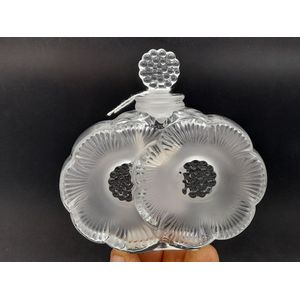
Lalique Twin Flower Scent Bottle
Lalique scent bottle, twin flower head design with matt and clear finish etched signature 'Lalique France' to base

Frosted Snowdrop Lalique Scent Bottle
Lalique scent bottle, frosted snowdrop floral detailing on clear crystal base, base engraved signature mark reads 'Lalique France'
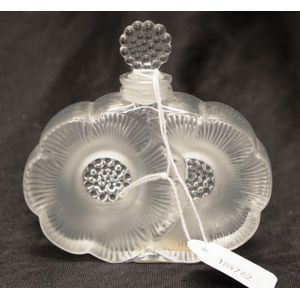
Lalique Blossom Crystal Scent Bottle with Decorative Stopper
Lalique 'Blossom' form crystal scent bottle with decorative stopper, marked to base, height 9 cm.

Lalique Perfume Bottle for Nina Ricci's L'Air du Temps
Lalique French glass perfume bottle in original box for Nina Ricci 'L'Air du Temps', bottle 8.5 cm high

Rene Lalique's 'Imprudence' for Worth Perfume Bottle (1938)
Rene Lalique 'Imprudence' perfume bottle for Worth circa 1938

Rare Blue-Stained Lalique Worth Perfume Bottle
A rare Rene Lalique Worth Flacon de Parfum with blue stain. The smallest and scarcest of the Worth perfume Co. 'Stars' bottles. Marcilhac 'Worth 1'. With raised R. Lalique signature, height 8.8 cm

Lalique Enfants Perfume Atomizer with Putti Motif
A Rene Lalique 'Enfants' perfume Atomizer features a 'Putti' motif in frosted glass. Part of the 'Enfants garniture de Toilette', introduced in 1931. Marcilhac 663, height 14 cm

Rare Lalique 'Epines' Perfume Bottle, c.1920
A rare Rene Lalique 'Epines' Flacon de Parfum c.1920 decorated in patinated briars motif under a domed stopper. The largest of the bottles from the 'Epines garniture de Toilette' collection. R Lalique raised signature. Marcilhac 591, height 11.3 cm

Lalique Cactus Perfume Bottle with Flowers
A Lalique Cactus form perfume bottle, height 10 cm and two flowers

Lalique Swan, Blue Bell Scent Bottle, and Leaf Dish
A Lalique swan form pin dish, height 9 cm, blue bell scent bottle, height 12 cm, and leaf form dish, diameter 14 cm

Lalique Crystal Sparrow Perfume Bottle, 14cm
Lalique France crystal 'Mesanges' perfume bottle decorated with in relief sparrow birds, etched to base, height 14 cm(stopper stuck)

Lalique 'L'Air du Temps' Display Bottle and Glasses
Marc Lalique 'L'Air du Temps' large display scent bottle, c. 1960 clear and frosted crystal, together with four Lalique glasses, chipped, all signed (5), height 32 cm. Provenance: Private Collection, NSW.

Lalique La Belle Saison Perfume Bottle
Lalique perfume bottle circa 1925 La Belle Saison' Houbigant Purfume bottle French glass with moulding made in France, height 10 cm'

Lalique Deux Fleurs Perfume Bottle and Stopper
Lalique 'Deux Fleurs' perfume bottle and stopper, in the form of two flowers, in clear and frosted glass, incised Lalique France to base, height 9 cm

Lalique Crystal Perfume Bottle - 10cm Height & Width
A Lalique crystal perfume bottle, height 10 cm, width 10 cm

French Art Nouveau Glass Perfume Bottle with Silver Overlay
An early 1900s French glass perfume bottle, silver overlay decoration in the form of an Art Nouveau honesty branches, the frosted stopper in the manner of Lalique. Height 11 cm.

Art Nouveau Glass Perfume Bottle with Silver Overlay Decoration
An early 1900s French glass perfume bottle, silver overlay decoration in the form of an Art Nouveau woman hair flowing into flowers and leaves, the frosted stopper in the manner of Lalique, marked Made in France to the base. Height 8 cm.

Rene Lalique Helene Scent Bottle, c1940, 14cm
Rene Lalique 'Helene ' Scent bottle marked R Lalique, France to base. c1940, 14 cm high.
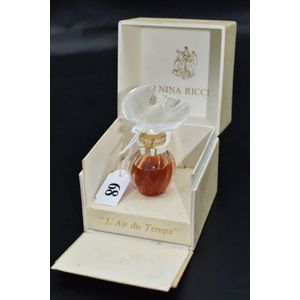
Lalique Dove Perfume by Nina Ricci
Nina Ricci boxed perfume in Collectors Lalique bottle with dove stopper

Lalique Lily of the Valley Perfume Bottle
Lalique lily of the valley perfume bottle lily of the valley decorated stopper, bottle marked to base, height 12 cm

Lalique Crystal Bird Perfume Bottle for Nina Ricci
Lalique for Nina Ricci crystal perfume bottle, the stopper in the form of a frosted glass bird, above a swirled glass base, mark to base, height 9 cm

Lalique Cactus Perfume Bottle, Frosted Glass, Signed
Lalique 'Cactus' perfume bottle, of globular form, in satin frosted glass with black accents, signed Lalique France to base, height 10.5 cm

Lalique Anemones Perfume Bottle with Etching and Label
Lalique vase Deux Anemones perfume bottle etching mark with cristal label 16 cm

Lalique Style Amber Perfume Bottle with Flower Stopper
Lalique style perfume bottle, of tapered oval form, with an amber frosted glass stopper decorated with flowers, height 6.5 cm

Lalique 'Deux Fleurs' Perfume Bottle and Stopper
Lalique 'Deux Fleurs' perfume bottle and stopper, in the form of two flowers, in clear and frosted glass, incised Lalique France to base, height 9.5 cm

Lalique Cactus Perfume Bottle with Black Enamel Nodules
A Lalique Cactus perfume bottle, late 20th century of globular form with a conforming stopper, in a frosted finish decorated throughout with nodules dotted with black enamel, height 10 cm

Lalique Le Nu Limited Edition Parfum Flacon
Lalique Cristal - Le Nu Edition Limitee 1996 parfum flacon, sealed with original parfum, small chip on collar. Engraved mark. Height 10.5 cm. Provenance: The Beverley Allen Collection

Lalique Sylphide Limited Edition Parfum Flacon
Lalique Cristal - Sylphide Edition Limitee 2000 parfum flacon, sealed with original parfum. Engraved mark. Height 12.5 cm. Provenance: The Beverley Allen Collection

Lalique Les Muses Parfum Flacon - Limited Edition 1994
Lalique Cristal - Les Muses Edition Limitee 1994 parfum flacon, sealed with original parfum, small chip on collar. Engraved mark. Height 12.5 cm. Provenance: The Beverley Allen Collection

Lalique Crystal Apple Perfume Bottle with Minor Chip
Lalique crystal grand Pomme apple form perfume bottle, height with stopper 13.5 cm, very small chip to leaf

Lalique 'Duex Fleurs' Perfume Bottle
Lalique 'Duex Fleurs' frosted and clear glass perfume bottle, etched Lalique France to base

Mid-century Lalique Glass Perfume Bottle, 9cm High
Lalique French glass perfume bottle, mid 20th century, 9 cm high

Lalique Sparrow Perfume Bottle, Signed
Lalique France Sparrow banded perfume bottle signed with etched script mark on base, height cm

Lalique Dahlia Crystal Perfume Bottle, 9.5cm Height
Lalique'Dahlia' frosted crystal perfume bottle inscribed to base, with original sticker, height 9.5 cm

Lalique Deux Fleurs Perfume Bottle - 11cm Height
Lalique style 'Deux fleurs' perfume bottle height 11 cm
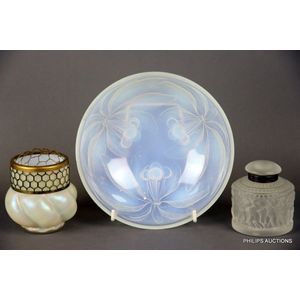
1930s Lalique, Kralik, and G. Vallon Glass Collection
A Lalique scent bottle, a Kralik vase, and a G. Vallon bowl, circa 1930s and after, a Lalique 'Enfants' scent bottle, introduced in 1931, pattern 609, with a later silver plated collar, inscribed Lalique France, a Kralik, mother-of-pearl' spiral lobed…
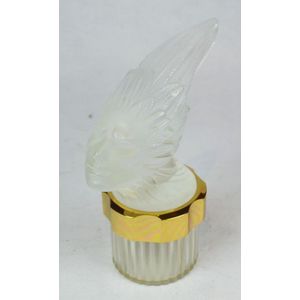
Lalique Indian Head Perfume Bottle with Bonnet Mascot Lid
A Lalique perfume bottle with bonnet mascot style, Indian head as the lid height 17.5 cm

Lalique Star Perfume Bottle for Worth's Dans La Nuit
Perfume bottle early 20th century, c1924, French Lalique glass spherical bottle with moulded star decoration in frosted blue, designed for the house of Worth's, Dans La Nuit perfume, moulded factory base stamp, French bottle 350ml, Creation R Lalique
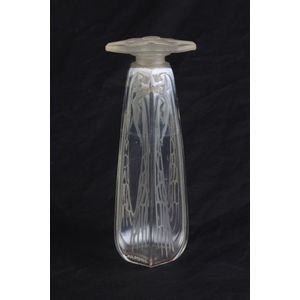
Lalique Cyclamen Perfume Bottle for Coty
Perfume bottle early 20th century, c1912, French Lalique glass Cyclamen, designed for Coty, moulded factory mark Lalique, height 13.5 cm

French Lalique Glass Perfume Bottle, c.1912
Perfume bottle early 20th century, c1912, French Lalique glass pan, moulded factory base mark R Lalique, height 10.5 cm, (a/f no stopper)

Lalique's Je Reviens Perfume Bottle with Worth Stand
Perfume bottle early 20th century, French Art Deco style by Rene Lalique, manufactured for the house of Worth's, unique blue perfume, Je Reviens in 1933, moulded factory base mark, Lalique - Made in France with nickel Worth stand height 31 cm

Lalique Moon-Shaped Perfume Bottle for Worth's Dans La Nuit
Perfume bottle mid 20th century, Lalique blue glass, moon shaped, made for Worth's Dans La Nuit, moulded factory base mark, R Lalique Creation 1000ml, height 25 cm

Lalique D'Orsay Perfume Bottle, Early 20th Century
Perfume bottle early 20th century, Lalique L'Elegance, made for the D'Orsay perfume Co, moulded factory base mark R Lalique, engraved monogram, moulded brand name D'Orsay to body, 7.25 x 725 cm

Lalique Deux Fleurs Crystal Perfume Bottle
Perfume bottle mid 20th century, c1935, French Lalique clear crystal, Deux Fleurs design, acid etched factory base mark, R Lalique, France, height 9 cm

Lalique Lily of the Valley Perfume Bottle
Lalique lily of the valley perfume bottle lily of the valley decorated stopper, bottle marked to base, height 12 cm.

Lalique Glass Nina Ricci Perfume Bottle - 32cm High
Lalique French glass Nina Ricci L'Air du Temps point of sale perfume bottle, 32 cm high

Lalique Table Mirror and Perfume Bottle Set
Lalique 'Boutons de Roses' crystal table mirror, after 1978 together with a Lalique 'Clairefontaine' clear perfume bottle, 25 cm and 7 cm high (2)
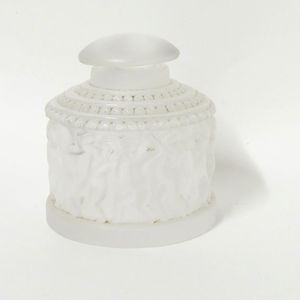
Lalique Enfants Flacon
A Lalique flacon, in the Enfants pattern, Lalique France in etched script to the base. 9 x 10 cm.

Lalique Duncan Perfume Bottle with Frosted Stopper
Lalique 'Duncan' perfume bottle and stopper, of rectangular form with central frosted glass panel depicting a pair of classical nudes, with frosted rectangular stopper, signed Lalique France to base, height 20 cm


 Loading more...
Loading more...